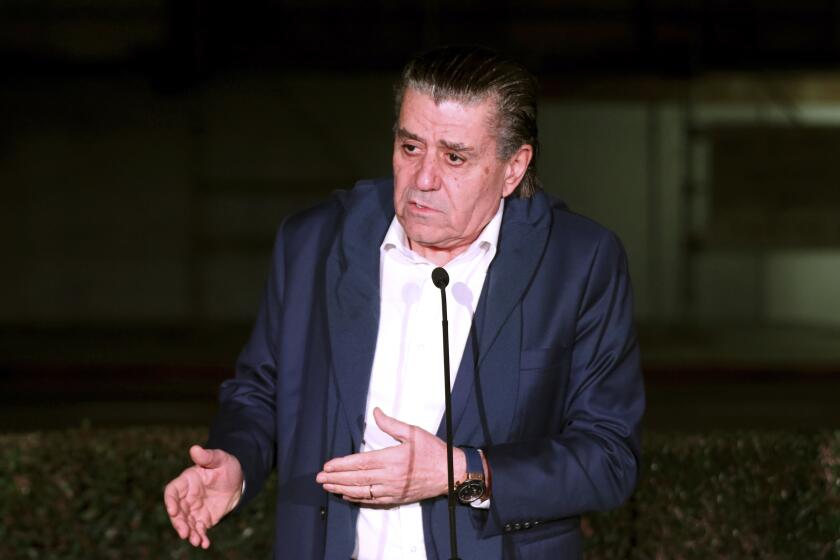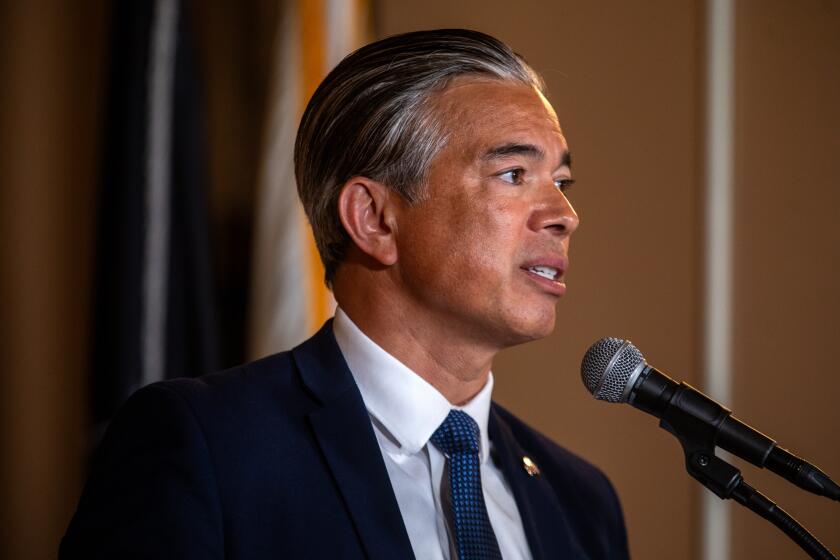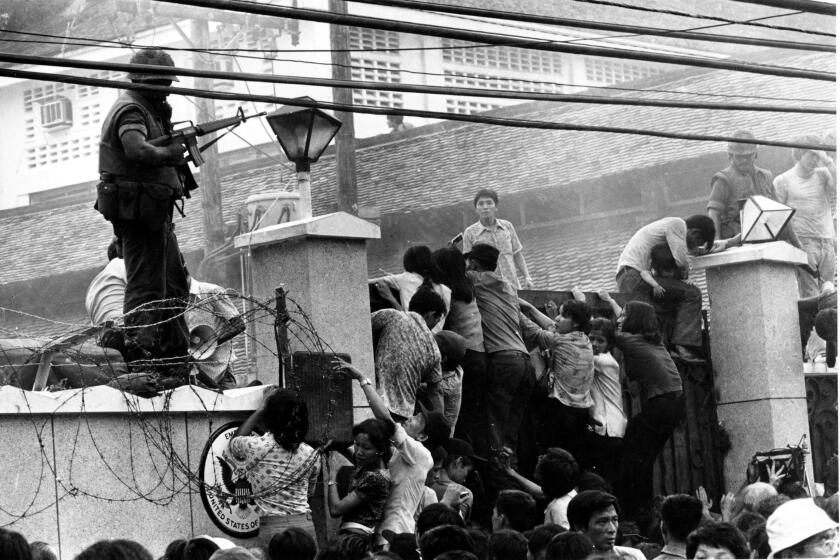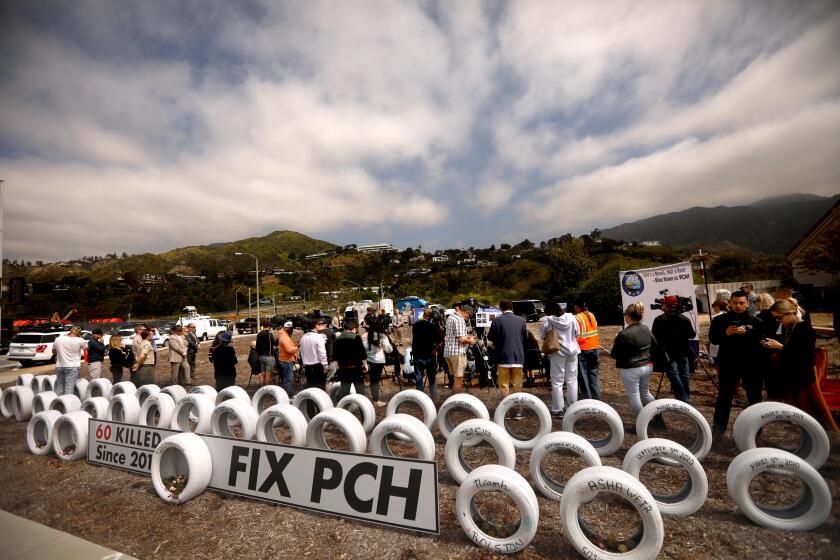Voters Get a Chance at Rail Plans, but It May Not Matter : Transportation: The advisory measure is the work of Supervisor Mike Antonovich, who favors a monorail system.
After seven years of debate about what kind of rail line to build in the San Fernando Valley and where to build it, on June 5 voters will finally have their say.
But that doesn’t necessarily mean it will make a difference.
The vote is strictly advisory, and transportation officials do not have to heed what the public says about the three rival rail plans on the ballot.
For one thing, the Los Angeles County Transportation Commission, which has the final word, already has rejected two of the plans and voted to extend the Metro Rail subway westward from North Hollywood to Van Nuys. Before voting in March, commissioners said they could not wait for the results of the advisory vote.
In addition, the ballot measure is multiple choice, and few expect a clear winner. A splintered vote is likely to be greeted by a Babel of conflicting interpretations from advocates of various plans.
The advisory vote will be conducted in an area that includes all of the San Fernando Valley, Glendale, Agoura Hills, Calabasas and Westlake Village.
Proposition A was placed on the ballot in February by county supervisors at the behest of Supervisor Mike Antonovich, who has been trying to breathe life into his nearly moribund plan to build a monorail along 16.5 miles of the Ventura Freeway from Universal City to Canoga Park.
Antonovich’s motion listed his monorail proposal first among the rail plans in the ballot referendum. The second position went to the county Transportation Commission’s approved plan to extend the downtown-to-North Hollywood Metro Rail subway 5.6 miles west to the San Diego Freeway.
The extension would be built on the Southern Pacific railroad’s Burbank Branch right of way, and would go underground through single-family neighborhoods of North Hollywood and Van Nuys.
Proponents say the Metro Rail extension is the only plan that will allay homeowner worries about noise, ground vibrations and visual blight. Although there is only enough money to build the line as far west as the San Diego Freeway, Metro Rail advocates say express buses can carry passengers to Warner Center and other West Valley destinations.
The third plan--fiercely opposed by many living along the Southern Pacific right of way--is to build a 14.1-mile light-rail system in a shallow trench--lined on both sides with berms--from North Hollywood to Canoga Park.
Light-rail advocates contend that fears of noise and visual blight from ground-level trains are unjustified. And because of its relatively low cost, they say, a light-rail line can be built all the way across the Valley.
Also included is a fourth option: no rail line at all.
Since unveiling his monorail plan more than two years ago, Antonovich has been continually frustrated in efforts to solicit broad support.
Few have been persuaded by his argument that a futuristic technology like a monorail in a high visibility setting along the freeway is needed to lure Valley commuters from their cars. When a 31-member citizens committee appointed by the Los Angeles City Council studied rail options in 1988, a monorail drew some interest, but members were reluctant to endorse it.
Most were wary because monorail is largely untested in this country, and it would add a new technology to the two already under construction in Los Angeles County--high-speed, high-capacity Metro Rail and ground-level light rail.
Until the referendum qualified for the ballot, the monorail plan appeared to be dying. Fearing that the ballot measure would bring Antonovich’s plan back to life, Metro Rail advocates went to court to try to block the measure.
On April 8, a state Court of Appeal declined to strike the measure from county ballots but expressed “serious doubts about the propriety of the use of such alternative options in a ballot proposition.”
The court also ordered the county to take the unorthodox step of including one argument for and against each option on the ballot, but gave proponents less than 24 hours to submit the arguments.
In the resulting rush, no one submitted an argument against the light-rail option, and Antonovich used the argument against the “no rail” option to pump again for a monorail.
Because of the confusing nature of the ballot and the accompanying arguments, those whose plans do poorly seem well positioned to argue that the results should be ignored.
Roger L. Stanard, a Warner Center lawyer and chairman of the Campaign for Valley Rail Transit, which supports the Metro Rail extension, called it a “rigged ballot measure” that favors Antonovich’s plan and would be “very hard to interpret.”
Nonetheless, Stanard said votes for the light-rail line and the Metro Rail line should be combined, “because this is really a choice between two routes--the freeway and the Burbank Branch. I don’t think people care about the type of system. They’re all boxes in which people sit and get moved from one place to another.”
Rosa Kortizya, Antonovich’s transportation deputy, said she expected a “splintered vote, and we’d like to get about 45% of the vote.”
But she indicated that, even if the monorail vote is smaller than that, Antonovich will continue promoting his plan on the assumption that “as time goes by, the unreasonably high cost of the Metro Rail extension will become obvious, and people will start to look for alternatives.”
She noted that the county Transportation Commission’s plan to build the subway extension starting in 1996 depends on continued federal funds for rail building and keeping cost overruns down--”both of which are not at all certain.”
Antonovich also contends that monorail is the only plan likely to attract private investors should the commission decide to save money by awarding a private firm a franchise to build and operate the system along the freeway. Rail experts say that the high cost of tunneling usually puts off private investors.
Both Metro Rail and monorail advocates have been soliciting funds to finance radio spots to support their plans.
Gerald A. Silver, an Encino homeowners group leader, has welcomed the ballot measure as a platform for his anti-rail views. He wrote two of the seven ballot arguments.
Silver has become a regular on radio talk shows, armed with government and academic studies that question the results of the 60 or more rail projects built or under construction in the country in recent decades.
He said he also has mailed several pieces of anti-rail literature to residents along the freeway, using a mailing list that has turned out more than 100 people at public hearings to protest any freeway rail line.
Silver declined to predict the outcome of the voting but said he was “hopeful that the public will finally see what boondoggles these rail projects are.”
PROS AND CONS OF RAIL OPTIONS Monorail along Ventura Freeway from
Universal City to Canoga Park
Advantages:
* Futuristic technology and high visibility along freeway might attract more riders than rival systems.
* Cost of $90 million to $110 million per mile is much less than subway.
* Equipment manufacturers might be willing to build and operate system on a for-profit basis.
Disadvantages:
* Requires passengers to change trains at Universal City to continue to Hollywood and downtown.
* Residential areas along freeway will incur visual blight, some noise, loss of privacy and increased congestion.
* Some critics say that elevated structures might collapse in a severe earthquake.
Metro Rail subway along Southern Pacific
railroad’s Burbank Branch from North Hollywood
to the San Diego Freeway
Advantages:
* Protects residential areas along route from noise and visual blight.
* Has wide support from business, civic and homeowner groups
* Passengers bound for Hollywood and downtown would not be forced to transfer in North Hollywood.
* High-speed, high-capacity system.
Disadvantages:
* Cost of about $200 million per mile.
* Because of high cost, can only be built as far west as the San Diego Freeway for now.
* Partly because of high cost, cannot be completed until year 2001 at the earliest.
Light rail in a trench/berm configuration
along the Burbank Branch
from North Hollywood to Canoga Park
Advantages:
* A complete cross-Valley system could be built for about $75 million per mile.
* Its cost makes feasible a future extension east to Burbank and Glendale.
* Light-rail cars can be made compatible with Metro Rail cars and the system could be upgraded in the future to a full Metro Rail operation, proponents say.
* Trench and berm would protect nearby residents adequately from noise, advocates say.
Disadvantages:
* Well-organized, vocal opposition among residents along the railroad right of way, who contend trains would be noisy and unpleasant to look at.
* Little public support, since most early advocates of light rail have joined the coalition supporting a Metro Rail extension.
No rail line
Advantages:
* Taxpayer dollars would not be spent on system that critics say is inflexible and fails to serve most travelers.
* Rail systems elsewhere seldom meet ridership projections and usually cost more than projected.
* Rail systems cost so much to operate that they drain money from buses, critics say.
Disadvantages:
* Despite cost overruns and failure to meet ridership goals, rail lines elsewhere are often popular, resulting in public support for additional lines.
* High costs for rail systems reflect reality that many commuters will not leave cars unless the alternative is modern and attractive, proponents say.
* Money not spent in Valley will likely be shifted to other Southland communities vying for rail lines.
More to Read
Start your day right
Sign up for Essential California for news, features and recommendations from the L.A. Times and beyond in your inbox six days a week.
You may occasionally receive promotional content from the Los Angeles Times.






